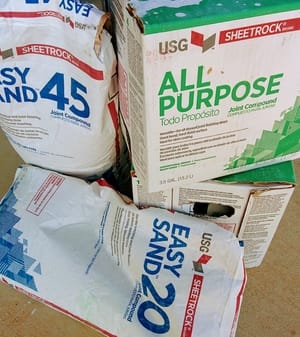
Different types of Drywall Mud
Last time you visited the local hardware store or big box home improvement store like the Home Depot® or Lowes® looking for drywall mud you may have been puzzled by the variety. Do all joint compounds work the same or should you use a certain type of mud for certain applications?
Let's discuss the two basic categories of drywall mud. Then we can discuss the choices within each category. This article is not meant as a review of any brand or recommendation of a certain product line, rather this is a general discussion that applies to several different brands of drywall compound.
What are the two main categories of drywall mud?
Quick Set Drywall Mud ("hot mud")
Quick set drywall mud comes in powdered form usually in plastic lined paper bags. The plastic lining keeps moisture out and preserves freshness. Keeping the powdered mud dry is critical. When water comes in contact with hot mud it begins an irreversible chemical reaction that causes the mud to harden.
Once quick set drywall mud hardens you cannot reuse it. If a bag of hot mud contains even a few small pieces of hardened mud, it can render the entire bag unusable. Hardened lumps of hot mud cause scratches in drywall seams and make it very difficult to create truly smooth finishes.
Hot mud set time
When it comes to hot-mud, there is a difference between hardening and drying. Hot mud hardens as a result of a chemical reaction. Manufacturers mix different amounts of hardening agents into the material causing it to set up at different times.
Hot mud is packaged according to the time it takes to harden. For example, quick set drywall mud is sold in packages labeled 5-minute, 20-minute, 45-minute, 90-minute or higher. This refers to the length of time it takes from when the powder comes in contact with water to when it hardens and can be re-coated.
Actual working time is generally less than the time listed. For example, 45-minute hot mud may begin to set up in 30-35 minutes. Hot dry conditions can cause 5-minute mud to set before you even get a chance to spread it on your patch.
The working time can vary slightly depending on a few factors. High humidity or cooler temperatures causes hot mud to take longer to set. If you need quick set drywall powder to set up faster than normal, mixing it with hot water instead of cold will usually do the trick.
Hot mud dry time
Remember, the time associated with quick set drywall compound is the hardening time, not the drying time. For instance, even though 45-minute hot mud may harden within 45 minutes, it can take several hours to dry completely depending on ambient temperature and humidity levels.
When using hot mud you will notice it turn from dark grey to white. The mud is not considered completely dry until it turns completely white in appearance. Unlike traditional drywall compound, it does not shrink as it dries, so it is possible to add additional coats of hot mud before it has completely dried. It is best however, not to paint over hot mud until it has completely dried.
When to use hot mud
Quick set drywall mud is great for small patch jobs where you don't want to wait 24 hours before applying a second coat. Hot mud is also used on large drywall jobs for bedding-in mesh drywall tape. This allows the pros to tape and first coat seams all within the first day on a job.
Many pros feel that quick set mud provides a stronger base coat and therefore protects better against cracking. Because of this, some use it as a first coat when finishing corner bead.
Most pros agree that when you use mesh drywall tape, you should always use quick set mud as a first coat. Mesh tape does not provide a strong a bond with the drywall paper and therefore needs the added strength of hot mud. Some manufacturers recommend using quick set compound when choosing mesh tape.
Quick set drywall mud is rarely used as a finish coat. Quick set mud is more difficult to sand than "lightweight all purpose" mud which makes it very difficult to create truly smooth surfaces. Even when hot mud is used for coating patches, a skim coat of lightweight all purpose mud is often used to finish the patch.
There are several brands of quick set drywall mud. The pros all have their preferred brands and different reasons for each. Two popular brands are USG SHEETROCK® brand EZ-sand and Gold Bond® brand Pro Form® quick set drywall mud.
Why is it called "hot" mud?
Why is it called "hot" mud? We cannot say for certain how it got that name but there are a couple of possibilities. As hot mud hardens, the chemical reaction creates a small amount of heat which may be a reason some people call it hot mud. Or, it could simply come from the fact that you have to move quickly because it will harden up on you if you don't finish within its specified time.
What is Durabond®?
Sometimes you will hear hot mud referred to as Durabond®. Durabond® is a trademarked name that refers specifically to a product made by USG®. It was one of the first types of quick set drywall mud that was used extensively in the workplace and for this reason the name became closely associated with quick set drywall mud.
Durabond® is similar to Sheetrock® in that it is simply a brand name that has become popular over the years. Most tradesmen these days prefer types of quick set drywall mud that are easier to work with and easier to sand than Durabond®. But in some areas, all brands of hot mud are referred to as Durabond®.
Pre-mixed drywall mud
The other main category of drywall mud is pre-mixed drywall mud. This is what most people think of when they talking about drywall mud.
Pre-mixed drywall mud is sold in either 4.5 gallon buckets or in boxes (cartons) containing a plastic bag of mud. Most often, the boxes of mud are also 4.5 gallons in volume but occasionally you will find 3.5 gallon boxes. Therefore, if you see a box of drywall mud that seems cheeper than most, make sure to check the volume. Pre-mixed drywall mud is, as the name indicates, pre-mixed and ready to use.
Pre-mixed drywall mud is almost always thinned with water before using. The amount of water used depends on how the mud will be applied. For example, bedding in tape requires a thinner than normal consistency.
A thin consistency is also needed when using automatic taping tools to allow a smooth flow of mud through the drywall mud pump. However, if it is too thin, it will be difficult to spread and will shrink back, creating voids. Texture mud is the thinnest of all. It takes time and training to understand what consistency of mud should be used with each application.
When shopping for drywall mud you may notice different types of pre-mixed mud. The three most commonly used are "all purpose", "lightweight all purpose" and "topping". There are of course several other types of joint compound available however these are the most common.
All Purpose Joint Compound
All purpose drywall mud, as the name indicates, is made for all applications. All purpose mud has bonding agents that increase the holding power of drywall tape so it is good for bedding in seams. It is sometimes used to first coat seams and corner beads.
All purpose is not often used as a finish coat because it is more difficult to sand than "lightweight all purpose" joint compounds. However some professionals will use it in limited applications for finish coat because it creates a durable finish. The downside is that it is harder to sand and therefore, the finishing has to be of very good quality.
Lightweight All Purpose Joint Compound
Lightweight all purpose drywall mud, as the name indicates, is made for all applications yet is lighter in weight than all purpose mud. Many pros believe that lightweight joint compound contains less binding agents and therefore is inferior when taping seams. However, it is hard to know for sure since manufacturers don't openly publish comprehensive lists of drywall mud ingredients. Lightweight compound is often used for first and second coat of seams and corner bead. It is almost always used as a finish coat because of its ease of sanding.
Topping compound
Topping compound is used less often then all purpose or lightweight mud. It can be used to top coat seams and corner bead. It is not recommended for taping joints. Topping compound is whiter in color than all purpose and even whiter than lightweight all purpose. One common use for topping mud is texture applications.
Are joint compounds compatible with one another?
Generally speaking, all types of drywall mud are compatible with one another. Joint compounds can be used over each other but most manufacturers do not recommend mixing the compounds together. It is always the best practice to refer to the manufacturer's specific recommendations.

